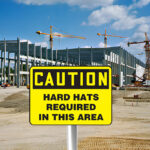Education is continually changing and evolving. So has the educational environment.
Signs aren’t only for decoration. In the right hands, they can be valuable resources to enhance spaces such as classrooms and schools. They can be essential teaching tools besides helping people to navigate through the environment safely.
We’re going to dive straight into it. The article will look at everything you need to know to design efficient signs for schools and classrooms from looking at colors to interaction.
Guide to school and classroom design
Every sign needs to be unique. The principles that work for advertisements won’t necessarily apply to signage in a school. You need to design the products with its specific goals and final destination in mind.
What do you want from classroom and school signs?
- To convey information
- Double up as learning tools
- Make the space more attractive
- Boost creativity
- Customize areas
- To give directions
- Health and safety warnings
- Promote the school
- Encourage students
These points might differ from institution to institution, but at least some of them are probably relevant to yours. Even if you are running an alternative education institution or teaching your children at home, many of the following tips can help you too!
It’s important to remember that design isn’t limited to signage. You need to pay careful attention to the layout and aesthetic of the entire classroom and school too.
Researchers have shown in a report that the physical characteristics of classrooms can increase the learning progress of primary school pupils by as much as 16% in a single year. That can be pretty significant.
Different aspects like light, color, and use of space play a role here. It is all about how they combine to create an environment that is stimulating but not overly distracting.
You want to use signs that contribute to these positive effects.
Tool for learning
To start, we’ll talk about how teachers can use signs to help teach their pupils.
One of the significant innovations in modern education is that educators now recognize a variety of learning models. These are different types of instructions. They help to cater to the range of preferences and learning styles that students might have.
Not everyone learns the same way. You can do more than write on the blackboard and recite the work.
Signs can be a fantastic way to incorporate different teaching methods into the classroom. They can be especially powerful as visual tools. Some topics can be efficiently taught using posters and signs.
An example of this in a primary school can be to use a range of signs to help you teach younger children the alphabet.

An example of this in a high school and middle school would be a poster of the periodic table.
You can include graphics on both of these posters to illustrate the information. You can also create opportunities for them to refer to these signs when they are doing related work in a lesson.
Signage like this can give the students a breather from staring at the blackboard or their textbooks. You can use it as a change of pace and help them gain a different perspective on a topic.
Importance of graphics
Pictures are one of those topics that will always pop up when you are talking about signs. But it is even more significant when you are designing anything for children.
Many students are visual learners. Seeing a portrayal of life cycles in pictures will probably make it easier to understand and remember than just reading and hearing about it.
But it’s not only that. You want the signs to appeal to your pupils too. Graphics are much more interesting to look at than just words. It’s all about finding the balance between using just enough words to convey the message and using so many that they become tedious.
You need to take the age of the children into account. The younger the children, the higher the ratio of pictures to words should be. It is the same principle that authors use in youth books.
Many educators prefer to use cartoon-like graphics on their classroom signs. Goofy and fun drawings can help them to make it appealing to younger children. On the other hand, you want to use detailed and anatomically correct drawings for a high school biology class.
Of course, not all signs in a school or classroom are meant to be teaching tools. Some will be there to convey information, like directions and safety information, to parents and visitors as well as pupils. But even with these, graphics such as arrows are vital to helping you communicate the point with limited words.
Intelligent interaction
One of the best ways to form connections in the brain is through interacting with it. Your students will remember the work much better if they can engage with it in a hands-on way.
Ask yourself how you can make their learning experience more interactive.
Your students will thank you for making lessons more fun and therefore more memorable.
It’s crucial to consider this when designing signage for schools and classrooms. There are many ways your students can interact with signs.
Here are just a few ways to incorporate these elements into the design:
- Leave spaces or gaps on the sign where students can “fill in” information
- Design signage where you can move around pieces to mix and match.
- Make boards that they can draw on.
- Create multiple posters that students can arrange in different orders.
You can use digital signs, magnetic signs, signs with interchangeable slots, or ones with blackboard or other materials that can be written on and erased.
Imagine the alphabet posters in our previous example. You can leave a blank space under each letter. There, students can draw a picture that matches it, or select a premade image to stick on that spot.
A pro tip is that just like adults, children feel more secure and comfortable if they feel like they have a degree of ownership in a place. So why not give them a controlled way to make their mark on the classroom?
Motivational posters
Nowadays, people are becoming more and more aware of the benefits of holistic approaches to education. It’s not only about teaching kids subjects like mathematics and science. But also about helping them develop in other areas like social skills and self-care.
Unfortunately, schools can sometimes be daunting places. Exams, reports, and homework can be a stressful experience for pupils.
That’s why it can be crucial to encourage pupils too.

As part of this, it can be helpful to design a few motivational signs for your school and classrooms too. You can use banners to cheer on the school’s sports team. Or write well wishes for the exams on LED message centers.
It can be a good idea to distinguish these from educational signs by using other fonts, colors, and images.
Color and mood
We all know that kids love colorful things. And it is undoubtedly true that it can liven up a room. But what is the best way to use colors in your classroom and school signs?
Signs can be an excellent way for educators to bring a pop of color into the classrooms. Using bright shades can undoubtedly help to draw attention to the poster. So it is a good idea to use plenty of colors in the critical ones.
But you don’t want to cross the line where the colors are overstimulating. To avoid this, carefully select which signs can have more toned-down hues and which ones need to stand out.
Overall, younger children enjoy warmer and brighter colors more than older students. These can be orange, red and so on.
But as they begin to transition to middle school, you might want to stick with a cooler palette. At this age, students need to be able to concentrate more. Muted colors like blue and green can help promote this state of mind.
Don’t forget to show some school pride with your signage. It’s a great idea to try to incorporate your institution colors in most of your outdoor signs. These will typically be seen by parents and visitors. By using school colors and logos, you can help create a visual identity for the institution and distinguish it from others.
Many educators find it useful to put a sign showing off the school motto or anthem in their classrooms. Your colors should also accompany official school information such as this.
A unified scheme such as this can be a brilliant strategy to make your school look more professional.
Engagement vs. distraction
As you’ve probably noticed, there is a thin line that you tread in designing signage for classrooms and schools. It is the line between engagement and distraction.
The sign needs to be attractive enough to the audience so that it can serve its purpose. However, in this case, a large part of your audience consists of children who are in an educational institution to learn.
One of the teacher’s main goals is to help students focus on specific tasks.
You don’t want the signs to be so busy that the students sit staring at them.
It isn’t necessarily a problem with all the signs in a school like wayfinding signs, safety signs, and so on. You mostly need to be concerned with this in the case of signage in the classroom or in some cases, those visible from the class.
Here are a few tips for how you can stay on the right side of this line:
- Limit how much information you put on one sign. Try to keep it focused on one topic.
- You can unify your classroom and the signage by sticking to a theme. Themed content can be a brilliant tool in school to help make learning more appealing.
- Don’t use too many different colors. Instead, use palettes that combine well and match each other.
Different types of signs and examples:
For the most effective signage solution, you will probably need a variety of different products. Schools are such multifaceted environments. In the end, you will probably need indoor signs, as well as outdoor signs, each with their intended purpose.
Choosing the right product is a critical step in the design process. You need to make sure that it is suitable for the task at hand.
Let’s look at a few examples of signs that you can use and their designs.
Monument signs
One crucial purpose for signage at a school is to announce its presence to the world. You need a board for your school’s name. Monument signs are always a popular choice.
Sign companies can make them from many materials in a variety of shapes and appearances. Overall, they are very customizable.
Take a look at the sign we made for Best Academy School. It shows off the institution’s colors and even has a graphic for the school’s mascot. We really like the pole holding up the sign – it’s made to look like books! The board is an excellent example of displaying school pride and what distinguishes this school from others.
Vehicle graphics and wraps
Educational institutions have a range of different infrastructure and types of property. They will usually own different vehicles used to transport the students, teachers and so on.
These vehicles can be a fantastic way to represent your school out in the world. So why not invest in some vehicle graphics?
You can choose wraps or magnetic strips. Make sure your design represents a combination of fun and neat professionalism, like the example above.
Setting up for success
It takes careful consideration to design signs for classrooms and schools. You need to cater to the unique requirements of your audience and the environment. Using signs can help you improve your students’ learning experience and make school more engaging.
As we’ve said, you can use a variety of different products at your school. Take a look at the comprehensive guide to the different types of signage & their uses for more information on what’s right for you.




